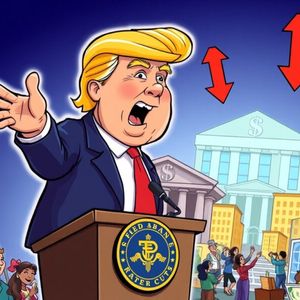Fed Rate Cuts: Trump’s Bold Call to Unleash Economic Growth
9 min read
BitcoinWorld Fed Rate Cuts: Trump’s Bold Call to Unleash Economic Growth In the dynamic world of global finance, few statements grab headlines quite like those from influential political figures regarding monetary policy. Recently, former U.S. President Donald Trump weighed in on a topic of immense interest to markets worldwide: the potential for Fed Rate Cuts . His assertion that the U.S. economy, while already performing well, would ‘improve further’ with a rate reduction, and his direct call for the Federal Reserve to act ‘this week,’ has ignited considerable discussion. But what exactly do these comments signify for the broader economy, and perhaps more pertinently for our audience, what could they mean for the volatile and fascinating cryptocurrency market? What Exactly Did Trump Say About Fed Rate Cuts ? Donald Trump’s recent remarks were direct and unequivocal. He stated that despite the current economic strength, the United States economy would experience an even greater boost if the Federal Reserve were to lower its benchmark interest rates. This isn’t a new stance for the former President; during his time in office, he frequently criticized the Fed for not cutting rates more aggressively, arguing that higher rates were stifling economic potential. His latest comments underscore a consistent belief that lower borrowing costs are a key ingredient for accelerated economic expansion. He views the current economic performance as robust, but sees significant untapped potential that could be unlocked through monetary easing. This perspective often aligns with a desire to stimulate investment, consumer spending, and overall business activity. Understanding the Federal Reserve’s Role and the Power of Fed Rate Cuts To fully grasp the implications of Trump’s call, it’s essential to understand the Federal Reserve’s role. The Fed, as the central bank of the United States, has a dual mandate: to maximize employment and maintain stable prices (control inflation). It achieves these goals primarily through adjusting the federal funds rate, which influences interest rates throughout the economy. How Interest Rates Work: When the Fed raises rates, borrowing becomes more expensive for banks, businesses, and consumers. This can cool down an overheating economy and combat inflation. Conversely, when the Fed implements Fed Rate Cuts , borrowing becomes cheaper, encouraging spending and investment. Stimulating Growth: Lower rates mean cheaper mortgages, car loans, and business loans. This incentivizes individuals to buy homes and cars, and companies to expand, hire more staff, and invest in new projects. Controlling Inflation: The delicate balance lies in stimulating growth without triggering excessive inflation. Too much money chasing too few goods can lead to rising prices, eroding purchasing power. The Fed’s decisions are based on a complex assessment of economic data, including inflation rates, employment figures, GDP growth, and global economic conditions. They aim for a ‘soft landing’ – guiding the economy without causing a recession or runaway inflation. What Are the Potential Benefits of Fed Rate Cuts for the Economy? A reduction in interest rates, as advocated by Trump, is generally seen as a powerful tool to inject liquidity and stimulate various sectors of the economy. Here are some key potential benefits: Lower Borrowing Costs: For businesses, this means cheaper loans for expansion, equipment, and innovation. For consumers, it translates to lower mortgage rates, reduced credit card interest, and more affordable car loans, freeing up disposable income. Increased Investment: With lower borrowing costs and a potentially brighter economic outlook, businesses are more likely to invest in new projects, expand operations, and create jobs. This can lead to a virtuous cycle of growth. Boost to Consumer Spending: Cheaper credit and increased confidence often lead to higher consumer spending, which is a major driver of economic activity. People might be more inclined to make big purchases or take on new debt for consumption. Stronger Exports: Lower interest rates can sometimes lead to a weaker domestic currency, making a country’s exports more competitive on the global market. This can benefit export-oriented industries and improve the trade balance. Higher Asset Valuations: Lower rates can make equities and other assets more attractive compared to fixed-income investments, potentially boosting stock market performance and wealth for investors. Are There Any Risks or Challenges Associated with Aggressive Fed Rate Cuts ? While the benefits of rate cuts can be appealing, the Federal Reserve must also consider the potential downsides and risks. An overly aggressive or ill-timed easing can lead to unintended consequences: Inflationary Pressures: If the economy is already strong, significant rate cuts could lead to too much money chasing too few goods, resulting in inflation that erodes purchasing power. This is a primary concern for the Fed. Asset Bubbles: Extremely low interest rates can encourage excessive risk-taking and speculation, potentially leading to bubbles in asset classes like real estate or stocks, which could burst and cause financial instability. Signaling Economic Weakness: Sometimes, rate cuts are interpreted by markets as a sign that the Fed sees underlying weakness in the economy, which can paradoxically reduce confidence and lead to a downturn. Reduced Policy Leeway: If rates are cut too low, the Fed has less room to maneuver in the event of a future economic downturn. This limits their ability to provide further stimulus when truly needed. Impact on Savers: Low interest rates can penalize savers, particularly retirees on fixed incomes, as the returns on savings accounts and bonds diminish. The Fed’s challenge is to find the ‘Goldilocks’ zone – rates that are ‘just right’ to support growth without triggering inflation or instability. How Do Fed Rate Cuts Influence the Cryptocurrency Market, Especially Bitcoin? This is where the discussion becomes particularly interesting for cryptocurrency enthusiasts. While traditional economic theory focuses on fiat currencies and established markets, monetary policy decisions by central banks, particularly the Federal Reserve, have a profound ripple effect that extends to digital assets like Bitcoin and the broader crypto market. Here’s how Fed Rate Cuts can influence cryptocurrencies: Increased Liquidity and Risk Appetite: When the Fed cuts rates, it generally signals a more accommodative monetary policy. This injects more liquidity into the financial system, making money cheaper and more abundant. In such an environment, investors often become more willing to take on risk. Assets perceived as ‘riskier,’ like cryptocurrencies, can benefit as investors seek higher returns than those offered by traditional, lower-yielding investments. Weakening of the US Dollar: Lower interest rates can make the U.S. dollar less attractive to foreign investors, potentially leading to its depreciation. A weaker dollar can make dollar-denominated assets, including Bitcoin, appear more appealing to international buyers. Furthermore, some view Bitcoin as a hedge against fiat currency devaluation, a narrative that strengthens when central banks are actively debasing their currencies through easing policies. Search for Yield: With interest rates on traditional savings accounts, bonds, and other fixed-income instruments falling, investors are compelled to look elsewhere for better returns. The high volatility and potential for significant gains in the crypto market can attract capital from investors disillusioned with low-yield conventional assets. Inflationary Concerns: If Fed Rate Cuts lead to fears of inflation, Bitcoin’s narrative as ‘digital gold’ or a store of value against inflation can gain traction. Historically, Bitcoin has sometimes been seen as an uncorrelated asset or a hedge against traditional financial system instability and inflationary pressures. Potential Crypto Market Reactions to Fed Rate Cuts The impact isn’t always straightforward and can depend on market sentiment and the reasons behind the cuts: Scenario/Interpretation Potential Crypto Market Reaction Cuts signal economic strength/proactive stimulus Generally positive. Increased liquidity and risk appetite could drive demand for Bitcoin and altcoins. Cuts signal underlying economic weakness/recession fears Potentially negative in the short term. Crypto might be sold off alongside other risk assets as investors flee to safety (e.g., USD, gold). Cuts lead to significant inflation fears Mixed. Could be positive for Bitcoin’s ‘inflation hedge’ narrative, but overall market instability could still weigh on prices. While the direct correlation isn’t always linear, the broader macroeconomic environment shaped by the Federal Reserve’s monetary policy, including Fed Rate Cuts , undoubtedly plays a significant role in influencing investor behavior and capital flows into and out of the cryptocurrency space. Expert Opinions and Market Expectations on Fed Rate Cuts Market analysts and economists hold diverse views on the likelihood and timing of future Fed Rate Cuts . Some believe that with inflation showing signs of cooling and the labor market remaining robust, the Fed might be inclined to ease policy to prevent an unnecessary slowdown. Others argue that inflation remains a persistent threat, and premature cuts could reignite price pressures, necessitating further tightening later. The market often tries to ‘price in’ potential rate changes, meaning current asset prices already reflect investor expectations. Any deviation from these expectations – whether the Fed cuts more or less than anticipated, or at a different time – can trigger significant market reactions across all asset classes, including crypto. Actionable Insights for Crypto Investors Given the potential influence of Fed Rate Cuts on the crypto market, what should investors consider? Stay Informed: Keep a close eye on Federal Reserve announcements, economic data releases (inflation, employment), and expert analyses. Understanding the macroeconomic landscape is crucial. Diversify: While Bitcoin and other cryptocurrencies can offer significant upside, they are also highly volatile. A diversified portfolio can help mitigate risks. Understand Your Risk Tolerance: Be prepared for price fluctuations. Monetary policy shifts can introduce volatility, and understanding your comfort level with risk is paramount. Long-Term vs. Short-Term: Short-term market reactions to Fed news can be unpredictable. Consider your long-term investment strategy rather than reacting impulsively to every headline. Donald Trump’s call for Fed Rate Cuts highlights a persistent debate about the optimal monetary policy for the U.S. economy. While his perspective emphasizes the potential for accelerated growth, the Federal Reserve faces the complex task of balancing growth with inflation control and financial stability. For the cryptocurrency market, the implications of such cuts are multifaceted. Lower rates can indeed fuel risk appetite and potentially weaken the dollar, making digital assets more attractive. However, the underlying reasons for the cuts and the broader economic context will ultimately determine the long-term impact on Bitcoin and beyond. As always, the intersection of politics, traditional finance, and the burgeoning world of digital assets remains a fascinating and unpredictable space. Frequently Asked Questions (FAQs) Q1: What is the Federal Reserve’s primary goal when considering Fed Rate Cuts? A1: The Federal Reserve’s primary goals are to achieve maximum employment and maintain stable prices (control inflation). Fed Rate Cuts are considered when the Fed believes the economy needs stimulus to support employment or if inflation is under control. Q2: How do lower interest rates affect borrowing for individuals and businesses? A2: Lower interest rates make it cheaper for individuals to borrow money for mortgages, car loans, and credit cards, and for businesses to secure loans for expansion, equipment, and operations. This generally encourages more spending and investment. Q3: Is there a direct, immediate correlation between Fed Rate Cuts and Bitcoin’s price? A3: While Fed Rate Cuts can influence market liquidity and risk appetite, which often benefits Bitcoin, the correlation is not always direct or immediate. Bitcoin’s price is influenced by many factors, including market sentiment, regulatory news, technological developments, and broader macroeconomic trends. Q4: Why might some economists be cautious about implementing aggressive Fed Rate Cuts? A4: Economists might be cautious due to concerns about reigniting inflation, creating asset bubbles, or signaling underlying economic weakness. There’s a delicate balance between stimulating growth and maintaining long-term economic stability. Q5: How does the concept of ‘digital gold’ relate to Fed Rate Cuts? A5: The ‘digital gold’ narrative for Bitcoin suggests it can act as a hedge against inflation and currency devaluation. When central banks implement significant Fed Rate Cuts , potentially leading to increased money supply and inflation fears, Bitcoin’s appeal as a scarce, decentralized asset can grow as an alternative store of value. Q6: What should crypto investors do when there’s talk of potential Fed Rate Cuts? A6: Crypto investors should stay informed about macroeconomic developments, understand their personal risk tolerance, and consider how potential liquidity injections or dollar weakening might affect the crypto market. It’s advisable to focus on long-term strategies rather than reacting to short-term volatility. If you found this article insightful, please consider sharing it with your network! Your support helps us continue to deliver timely and comprehensive analyses of the evolving financial landscape. To learn more about the latest crypto market trends, explore our article on key developments shaping Bitcoin price action . This post Fed Rate Cuts: Trump’s Bold Call to Unleash Economic Growth first appeared on BitcoinWorld and is written by Editorial Team

Source: Bitcoin World



